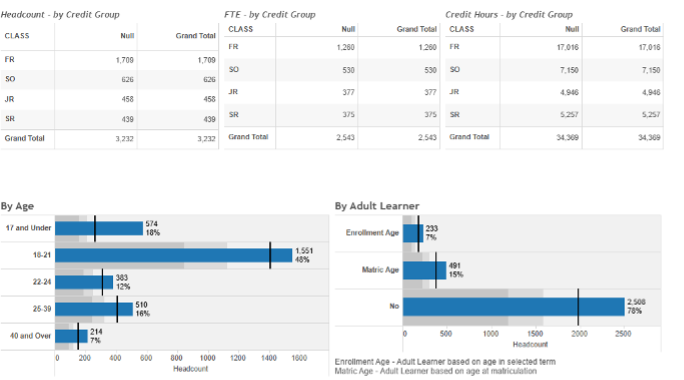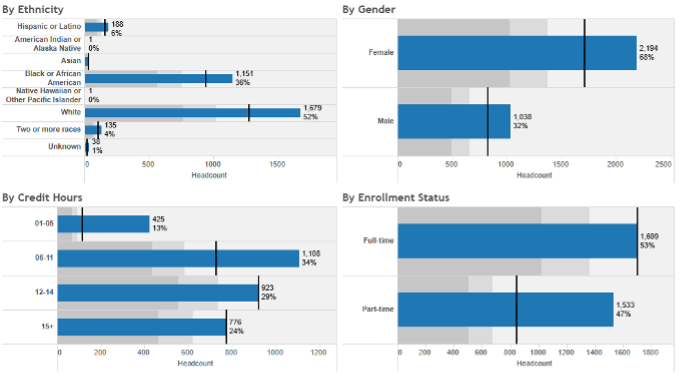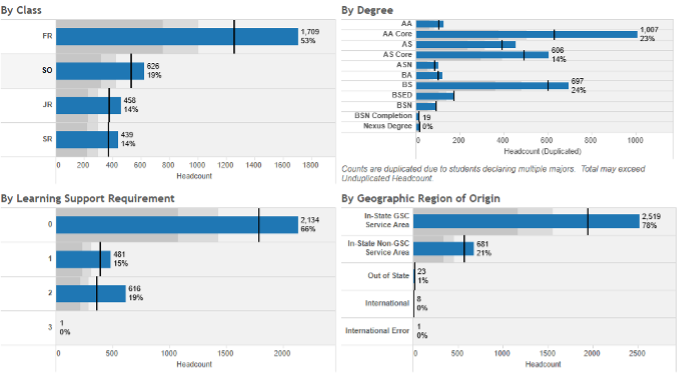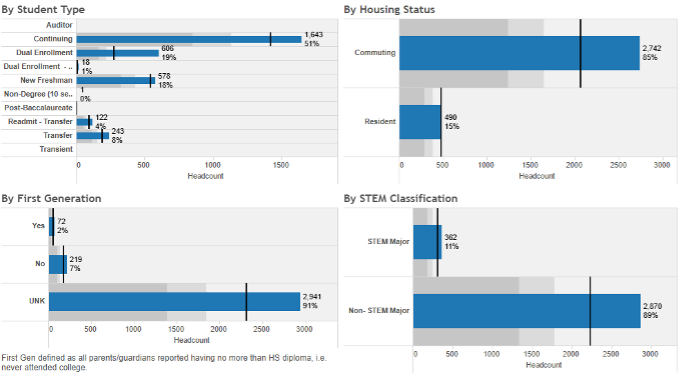Mission Statement
Gordon State College strives to provide a nurturing learning environment where students can grow academically and personally, preparing them for success in life and for making positive contributions to regional workforce needs.
Core Values
- Commitment to Excellence - Prioritize high standards in all endeavors, striving for distinction in education, research, and community engagement.
- Student Success - Focus on enhancing regional workforce by effectively preparing students for successful careers, thereby ensuring a substantial return on their educational investment.
- Innovation and Creativity - Encourage creative thinking and innovative solutions, driving progress and adapting to the evolving needs of our society and the wider world.
- Belonging - Embrace and celebrate multiple perspectives, fostering an environment that enriches learning and promotes respect and understanding.
Student Profile Data for Fall 2024
PART 2. Observations, Next Steps, and Reflecting on Momentum Work
The last year has been significant for Gordon State College's (GSC) student success team. We have spent the previous year instituting innovative programs and reimagining several older programs. Notably, the Spring of 2023 was the first entire semester for our Faculty Mentor program. While the program has had its challenges, we recognize that building such a robust program from the ground up is difficult. In addition, we relaunched our early alert program (Always Alert). Always Alert had not been functioning since 2021. As a result, we had to invest considerable time in adapting a new platform to manage the program's workflows. We also had to recruit and train academic coaches for the program. In addition, we began an attendance-taking pilot in Fall 2024 that includes select core courses. We have already seen some preliminary evidence indicating that this will positively impact student success and retention (a decrease of individual class midterm Fs by 10% from Fall 2023 to Fall 2024 and a 4% decrease of at-risk alerts from Fall 2023 to Fall 2024 for our Week 11 progress report). Adding to the above, we have committed ourselves to a more robust professional advising program. We have expanded to six professional advisors who advise all GSC students up to 60 credit hours. We also have a dedicated advisor for students who have been readmitted to GSC after academic suspension. In addition, we have a dedicated first semester advisor for nontraditional transfer students.
Communication/Outreach to Students
Part of our momentum work is to streamline and standardize our communication and outreach to students. In this effort, we have launched new messaging and communication campaigns. Some examples include:
- Probation messaging campaign - In the Spring of 2024, we launched a student on probation messaging campaign to educate students on academic probation about the challenges they face unless they improve their academic performance. This campaign, sent through Navigate, provides accessible information about financial aid, tutoring and support services, and more.
- Outreach to Math Learning Support students - We also launched an outreach campaign for math learning support students. In the Fall of 2023 and Spring of 2024, administrators visited each math learning support section to encourage students and talk to them about how they can succeed. We also send helpful emails to math learning support students every two weeks, including support service information and growth mindset content. We continued this outreach in Fall 24.
- Academic leadership visits to FIRE classes - Like the approach with math learning support, President Green has visited each FIRE 1000 course during the first week of class (Spring 2024) to talk to students about their academic journey and how they can succeed. President Green also visited FIRE courses in Fall 2024, and Dr. Shubitz visited as well.
- Review official communications to students - We have rewritten the letters that Academic Affairs sends to students put on Academic Probation or Academic Suspension at the end of each term. In addition, as of Fall 2024, professional advising has begun to draft pre-written outreach campaigns with a variety of nudges. All professional advisors will use these campaigns starting in Spring 2025.
Scheduling (Top 5 Strategies for Success)
We have engaged in continuous conversations about data-driven scheduling, as this is one of our ASPIRE top five strategies. Our discussions about data-driven scheduling partially emerged from our experimentation with block scheduling in the 2022-2023 AY. Due to challenges with block scheduling, we have begun to review our class scheduling patterns and use data, such as ABC rates and course fill rates, to guide how we schedule core classes. The culmination of this will be the use of CourseLeaf software (which we have used for 3 years) to pre-generate course schedules based on student needs and course demand. Finally, we have also made a commitment to moving up our timeline for publishing course schedules in future semesters. Traditionally, GSC has published courses one semester in advance. This has often led to problems for students who desire more transparency and predictability when planning their academic progress. We are now moving toward publishing course schedules a year in advance. Our first step in this process is to finalize and publish the Spring 2026 schedule by May 2025. We hope to move up the schedule even more in the future.
Student Affairs Initiatives
Complementing the accomplishments of Academic Affairs, Student Affairs is also making great strides toward promoting retention and student success. Academic Affairs has taken over complete ownership of New Student Orientations from Enrollment Services and Academic Affairs. Our Dean of Students, Latoya Stackhouse, has led an effort to redesign our NSO to be more effective in promoting long-term student success. Student Affairs has also taken steps to encourage engagement and belonging among both residential and commuter students, including the launch of four Living and Learning Communities (LLCs) in Fall 2024. We are still awaiting data concerning the impact of the LLCs.
Retention and Success Progress and Data
Over the last two years (since enrollment and retention lows during the early part of the Covid-19 pandemic), we have seen substantial retention and success progress across various student populations at Gordon State College. Some of the progress we have been making can be seen below in our Fall-to-Fall and Fall-to-Spring retention rates. Comparing the 2021 and 2022 FTFT cohorts, we saw a .9% increase in retention. Many of our efforts in AY 2023-2024 paid off, as we saw a 3.5% increase in retention. Also significant is that our latest Fall-to-Spring retention rate is at a record high of 85.7% (not seen since 2014). Preliminary data from Fall 2024 (midterm grades and Week 11 progress report data) indicates we are on track for solid Fall-to-Spring performance as the year ends.
FTFT Retention Cohort (Fall to Fall)
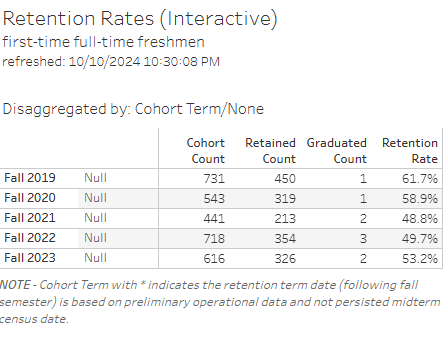
FTFT Retention Cohort (Fall to Spring)
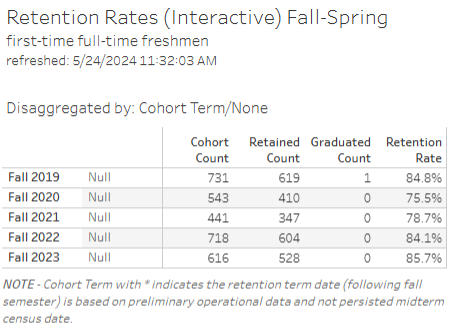
As an access institution, we pay a lot of attention to specific populations of students. Of the many populations worth noting, we have seen increased retention among our residential population and among African American males. Retention rates for our FTFT Fall 2023 residential students are up 7% over the Fall 2021 cohort. Retention rates for our FTFT Fall 2023 African American male students are up 8.5% over the Fall 2021 cohort. Please see the tables below for more information.
Table 1 - Residential Students
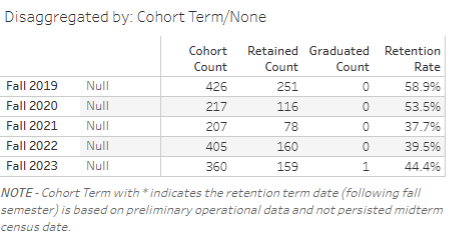
Table 2 - African American Males
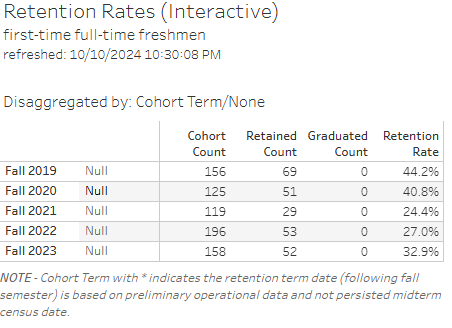
We are optimistic and excited about the progress of our work. We have used the past year to create a foundation for improvement. We are also engaging in a reorganization of student support and faculty development offices. In the summer of 2024, we launched the Center for Workforce Development, serving students and faculty in their academic and professional endeavors. CWD houses professional advising, faculty mentoring, career services, CETL, and more. The merging of several offices and initiatives has helped to foster a large collaborative team focused on helping students and developing faculty. In addition, we are also optimistic about the positive impact our advising redesign and faculty mentor programs will have on our students.
While we have had much success over the last year, there are places we fell short. One area was to gain more training for professional advisors and faculty advisors. Our professional advisors do not have the access to training resources they should have. In addition, many faculty advisors receive little to no formal training. Most of the experience that faculty advisors have is gained informally from colleagues and from being "on the job." This leads to substantial problems for students, often lengthening the time it takes them to complete programs and decreasing their course completion rate.
Starting in Spring 2025, we will dedicate more training-related resources to professional advisors and faculty advisors. This, along with an increased sphere for professional advising (we have moved to 60 credit hour professional advising) should have a significant impact on success and retention.
One area of struggle has continued to be faculty buy-in for mentoring. Faculty feel overworked and have not been as vested in mentoring as we would have hoped. As an institution, we need to do a better job of communicating the need for mentoring and provide more resources related to effective mentorship. We will make a big push in this area in the Spring and Fall of 2025.
In most cases, when we had success in our student success initiatives, it was due to the energy and dedication of individuals involved in those programs. When we do not succeed, it often owes to a lack of energy and commitment related to a lack of resources and personnel. Our greatest challenge is limited time and staff, which puts a lot of stress and significant demands on the individuals responsible for our success initiatives.
The biggest lesson that we have taken from the last year is that we need to have a focused, conscious, and purposeful approach to our programs. Programs such as the Mentor Program, Always Alert, FIRE, and our general advising apparatus must be aligned and mutually reinforcing. One step we have taken from this in the Fall of 2024 is to begin to codify specific processes related to student success and retention. The Student Success Center is working on a new Tutor and Student Worker handbook and a new Advising Handbook. We are also working on certifying our tutor program (level 1) and our Testing Center.
Besides the items we discuss below, Gordon State College must create a master student success communication plan, schedule, and process document (still in progress in Fall 2024). This is much in line with the developing manuals and handbooks for advising and tutoring. Such a plan, including all success activities and dates when those activities occur, will ensure that personnel changes and other related problems do not disrupt our success agenda. In this effort, we are currently working on a master schedule for success initiatives, which we will continue to develop during the next year. The creation of handbooks, manuals, and written processes will streamline our retention and success initiatives and apparatus.
Due to the changes at GSC, we are realigning our student success goals. In the future, Academic Affairs will focus on engagement, communication, and intervention to promote student success. A big part of this is fostering collaboration between faculty and professional advisors so that we can develop effective student success teams for first-year students. In this vision, first-year students will have (at least) four individuals that will support them, including:
- A professional advisor
- A faculty mentor
- A FIRE 1000 instructor
- An Always Alert academic coach (if needed)
In October 2024, GSC was awarded a Title III grant to help at-risk student populations at Gordon. Going forward (into the 2025-2026 AY), students in FIRE 1000 will also have access to a peer mentor.
In addition, we plan to use academic assistants within each department and EAB's Navigate to foster communication and cooperation among each student's success team. Mentors, advisors, FIRE instructors, and coaches can view relevant information about their students in Navigate and record data that will help and inform other success team members. Significantly, all our Student Success Inventory items are a significant part of creating functional success teams for students. That is the focus of our momentum plan this year.

